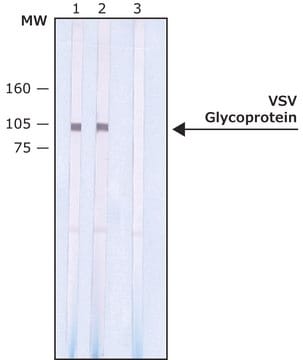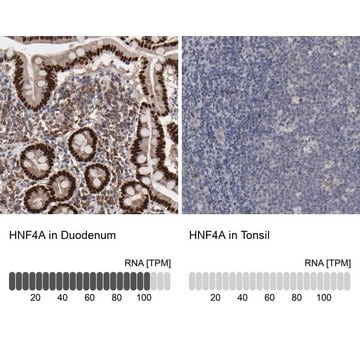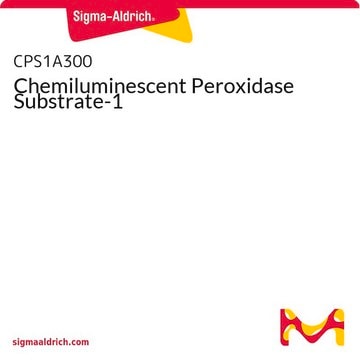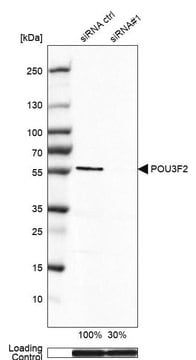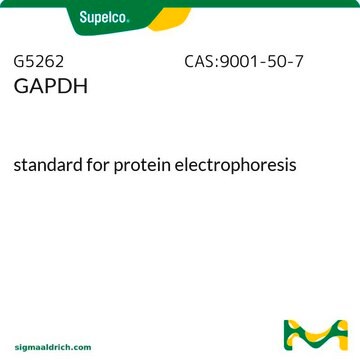推荐产品
生物源
mouse
共軛
unconjugated
抗體表格
purified from hybridoma cell culture
抗體產品種類
primary antibodies
無性繁殖
HRD1-5, monoclonal
形狀
buffered aqueous solution
分子量
antigen ~70 kDa
物種活性
human
濃度
~1.0 mg/mL
技術
immunoprecipitation (IP): 5-10 μg using lysates of human HEK-293T cells
western blot: 2-4 μg/mL using whole extracts of HEK-293T cells over-expressing human HRD1/SYVN1
同型
IgG1
UniProt登錄號
運輸包裝
dry ice
儲存溫度
−20°C
目標翻譯後修改
unmodified
基因資訊
human ... SYVN1(84447)
一般說明
Monoclonal Anti-HRD1/SYVN1 (mouse IgG1 isotype) is derived from the hybridoma HRD1-5 produced by the fusion of mouse myeloma cells and splenocytes from BALB/c mice immunized with a synthetic peptide corresponding to the C-terminal region of human HRD1/SYVN1 conjugated to KLH. β-Hydroxy β-methylglutaryl-CoA (HMG-CoA) reductase degradation protein (HRD1)/synoviolin (SYVN1) is an endoplasmic reticulum (ER)-membrane resident E3 ubiquitin ligase. It has a five-transmembrane domain, a really interesting new gene (RING)-finger domain and a proline-rich domain.
Synoviolin 1 (SYVN1), also referred as 3-hydroxy-3-methylglutaryl-CoA reductase degradation protein 1 (HRD1), is encoded by the gene mapped to human chromosome 11q13.1. It is mainly expressed in liver, spleen, prostate and pancreas.
免疫原
a synthetic peptide corresponding to the C-terminal region of human HRD1/SYVN1, conjugated to KLH. The corresponding sequence differs by two amino-acids in rat and mouse.
應用
Anti-HRD1/SYVN1 antibody, Mouse monoclonal has been used in immunoblotting and immunoprecipitation.
生化/生理作用
β-Hydroxy β-methylglutaryl-CoA (HMG-CoA) reductase degradation protein (HRD1)/synoviolin (SYVN1) protects against ER stress-induced apoptosis through ER stress-associated protein degradation (ERAD). The (RING)-finger domain mediates the transfer of ubiquitin from E2 to substrates. HRD1 expression is strongly induced by ER stress. It mediates proteasomal degradation via p53 tumor suppressor gene. Overexpression of HRD1 is implicated in the pathogenesis of rheumatoid arthritis.
Synoviolin 1 (SYVN1) plays a vital role in endoplasmic reticulum (ER)-associated degradation. The encoded protein acts as an E3 ubiquitin ligase and suppresses endoplasmic reticulum stress. It might also be involved in the protein quality control of optineurin (OPTN). Upregulated expression of the protein enhanced tau cytotoxicity and promoted cell survival in a study. SYVN1 interacts with Pael -R (substrate protein of familial Parkinson′s disease responsible gene Parkin) to promote neuronal cell death. It also increases degradation of APP (precursor of Alzheimer′s disease-causing protein amyloid β). SYVN1 activity is induced via inositol-requiring enzyme 1-X-box binding protein 1 (IRE1-XBP1) pathway. Therefore, drugs that enhance or suppress the expression of SYVN1, can be used as a therapeutic drugs for neurodegenerative diseases.
外觀
0.01M 磷酸缓冲盐溶液,pH 7.4,含 15mM 叠氮化钠。
免責聲明
Unless otherwise stated in our catalog or other company documentation accompanying the product(s), our products are intended for research use only and are not to be used for any other purpose, which includes but is not limited to, unauthorized commercial uses, in vitro diagnostic uses, ex vivo or in vivo therapeutic uses or any type of consumption or application to humans or animals.
Not finding the right product?
Try our 产品选型工具.
儲存類別代碼
10 - Combustible liquids
閃點(°F)
Not applicable
閃點(°C)
Not applicable
A de novo 0.57 Mb microdeletion in chromosome 11q13.1 in a patient with speech problems, autistic traits, dysmorphic features and multiple endocrine neoplasia type 1.
Mohrmann I
European Journal of Medical Genetics, 54, e461-e464 (2011)
Hrd1 facilitates tau degradation and promotes neuron survival.
Shen YX
Current Molecular Medicine, 12, 138-152 (2012)
ER signaling in unfolded protein response
Kaneko M and Nomura Y
Life Sciences, 74(2-3), 199-205 (2003)
Pharmacological basis research on neurodegenerative disease treatment of human novel endoplasmic reticulum protein HRD1
Kaneko M
Japanese Journal of Pharmacology, 133, 252-256 (2009)
Tetsuya Amano et al.
Genes & development, 17(19), 2436-2449 (2003-09-17)
Rheumatoid arthritis (RA) is one of the most critical articular diseases with synovial hyperplasia followed by impairment of quality of life. However, the mechanism(s) that regulates synovial cell outgrowth is not fully understood. To clarify its mechanism(s), we carried out
我们的科学家团队拥有各种研究领域经验,包括生命科学、材料科学、化学合成、色谱、分析及许多其他领域.
联系技术服务部门

